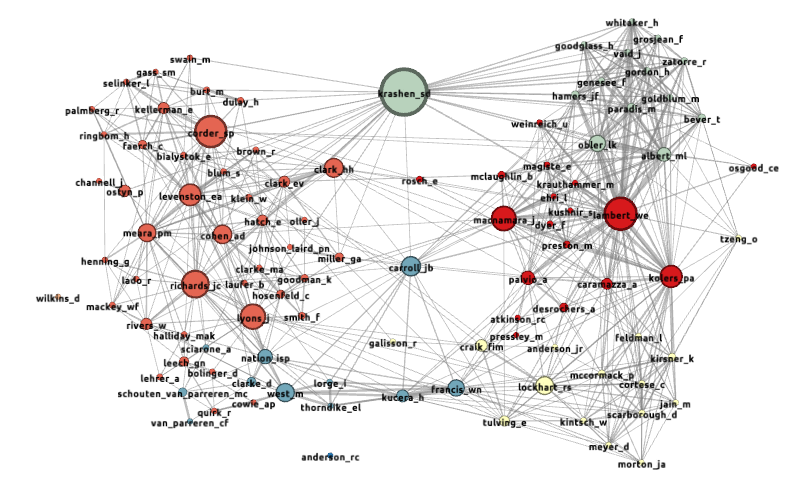| |
 |
|
| |
|
|
|
Lognostics Maps 1982-86
|
|
lognostics maps
VARGA
lognostics home
|

|
|
data source: VARGA 1982-86: data analysis July 2018
data: 255 papers, 102 nodes, 144 co-citations, 5+2 clusters
threshold for inclusion: Authors must be cited in at least eight different papers. Co-citations occurring less than three times are excluded.
3,248 unique sources are cited in the 1982-86 data set, with 102 sources cited in at least eight papers. The map shows the pattern of co-citations between these 102 most cited sources. The Sources are sized according to their betweenness centrality in the map. This measure gives prominence to sources who act as important links between the clusters, rather than to sources who are cited a lot within a single cluster. In this map, the most significant sources are Krashen, Lambert, Corder, Richards, Macnamara, Kolers, Levenston, Lyons, Kolers and Cohen.
The analysis identifies five major clusters in the data, together with two singletons: Anderson and Wilkins are frequently cited in this dat set, but not consistently co-cited with other sources.
Cluster 1: (top right) a group of psychologists mainly interested in brain functions and language. The key source in this cluster is Albert and Obler's (1978) The Bilingual Brain, cited 20 times in the data set.
Cluster 2: (centre right) a group of psychologists mainly interested in the semantic behaviour of bilinguals. The key figure in this cluster is Wallace Lambert, whose work is mainly focussed on the assessment of language performance in bilingual English/French speakers in Montreal. Atkinson, Pressley, Desrochers and Paivio make up a sub-cluster of researchers interested in imagery and mnemonics and their application to the problem of L2 vocabulary acquisition.
Cluster 3: (bottom right) a cluster of hard-core psychologists interested in memory and word recognition in L1. The key figures in this cluster are Craik and Lockhart who published a seminal paper on Depth of Processing in 1971.
Cluster 4: (centre bottom) This cluster consists of a set of frequency counts (Thorndike & Lorge, Kucera & Francis, West) and a group of linguists interested in the implications of this work for L2 vocabulary selection (Nation, Clarke). Van Parreren, Schouten-van Parreren and Sciarone make up a subgroup of vocabulary researchers publishing in this area, but mainly in Dutch.
Cluster 5: (top left) This cluster is the main L2 vocabulary acquisition group of influences. It comprises applied linguists with interests in vocabulary (Richards, Levenston, Cohen), linguists interested in semantics and corpus linguistics (Lyons, Leech), psycholinguists interested in lexical structures (Miller, Johnson-Laird), dictionaries (Quirk, Cowie), and small subgroups with a focus on reading (Goodman, Smith) and child language acquisition (Clark, Clark and Brown). The most significant influence in this cluster is Pit Corder, whose work mainly concerned interlanguage. A number of influential papers on vocabulary appeared in The Interlanguage Studies Bulletin - Utrecht. This journal was edited by Mike Sharwood Smith who was also trained in Edinburgh. However, only a handful of the sources are easily recognized as modern L2 vocabulary researchers, notably Cohen, Laufer, Nation, Meara, Ringbom and Richards.
The main structural feature worth noting in this map is the broad split between linguists on the left of the map, and psychologists on the right. There are hardly any co-citation links between the two halves other than the ones that link through Krashen or through Carroll. Also worth noting is the different pattern of co-citations in the two halves. The psychologists tend to have denser co-citation links than the linguists do.
|

